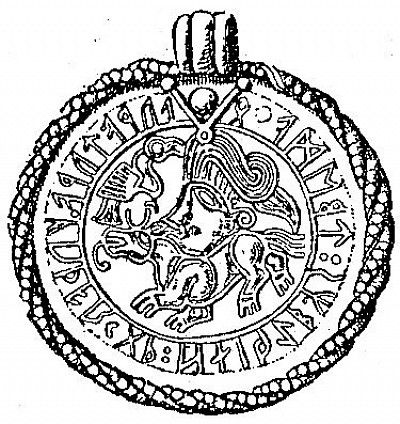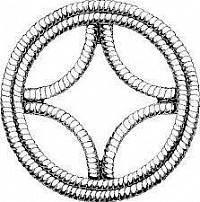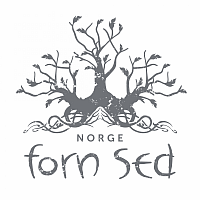Introduction to Ásatrú
What is Ásatrú?
Ásatrú is a religion which involves the worship of ancient Germanic and Scandinavian spirits and Nordic gods and goddesses. The name is derived from two Old Norse words. It means "faith in the Æsir," the Germanic and Norse gods.
A person who practices Ásatrú is called an Ásatrúar, and is sometimes refered to as a Heathen.
The term Ásatrú was coined in the 19th century by Grundtvig. The old Ásatrúar didn’t have a name for their faith. During conversion to Christianity around the year 1000, the term “hinn forni siðr” arose - the old seed, or the old customs
There are a large number of groups, large and small, who state that they are Ásatrú or a variant of Norse paganism or Heathenry. Freedom of religion is a right in America and many other countries, where one may worship, believe and practice as desired.
As such, it is not our place nor the goal of this website or its developers to “gatekeep” or otherwise tell people how to believe or worship the gods.
That said, the goal of this site is to support Icelandic Ásatrú and its close cousins in Scandinavia and worldwide which promote a traditional, academically studied, and animistic-pantheistic Ásatrú. Traditional Ásatrú is open to all interested spiritual seekers regardless of national origin, skin color, sex, gender, or LGBTQ+ identification. Traditional Ásatrú rejects “volkish” (aka “folkish”) beliefs. Ásatrú also is not considered an orthodoxic or orthopraxic spirituality. There are no authorities who can demand that rigid rules of belief or practice should be followed.
That is not to say that Ásatrú doesn’t have specific spiritual and cultural practices and traditions. There most certainly are clear traditions and beliefs in Ásatrú that come to us through Viking and old Germanic lore, and we present them on this site. There are regional variations, of course, as beliefs and practices, and even names of the Gods may be slightly different.
In America, Ásatrú did not arrive in a direct, clear form from Iceland, Scandinavia or the UK. It was conceived from the late 1970s as a chaotic mixture of Norse mythology, Wicca, and Anglo-Saxon practices, and two larger groups have also consistently pushed for racialist-völkisch agenda. We encourage you to study and learn how those things dramatically altered what is called Ásatrú by some Americans. If you are familiar with Icelandic Ásatrú or Nordic Forn Siðr, “American Ásatrú” may seem quite alien.
There are American groups which reject the völkisch-folkish agenda and the Wiccan-occult beliefs and practices. Generally these groups call themselves “Universalist” or “Tribal” Ásatrú, and tend to be less visible and without a large presence on social media.
Ultimately, we encourage you to study Traditional Ásatrú and thoroughly research the ancient beliefs and practices before you seek out any groups. Ásatrú is often called the spirituality with “a lot of homework” and we certainly find that to be true. In addition to the Eddas and sagas, there are many well-researched books and scholarly articles that will keep even the most avid of students busy for decades.
About Wicca and occultist beliefs and practices.
Occasionally, and perhaps more in America than other countries, Ásatrú is sometimes mixed quite heavily with Wiccan or occultist beliefs. Part of this is due to how Ásatrú was reconstructed in America. In the late 1970s, two formative groups both borrowed heavily from Wiccan practice and occultist beliefs - some of which were “Wiccan goddess” oriented and some of which were derived from the proto-Nazi Thule society of the late 1800s-1940s Germany.
They did this to “fill in gaps” and create structure for their new groups, but this was truly unfortunate because they simply had not done proper academic research. Where they simply did not know about the old heathen holidays of Iceland and Scandinavia, they tossed in the “Wiccan Wheel of the Year”.
Where they did not fully research or understand the ancient mystical beliefs and practices of the Nordic peoples, such as seiðr, galdr, runes, and other shamanic practices, they “filled in” with Wiccan and other foreign occult beliefs and practices. Things like Blavatsky’s beliefs in tarot, spiritual channeling, and “ancient Aryan masters” became popular - as did certain beliefs and practices of the racialist Thule society, including von List’s Wotanism, or Armanen runic “magic” and Marby’s “rune yoga” which have no real historical basis.
Icelandic Ásatrú
Íslenska Ásatrúarfélagið
The Icelandic Ásatrúarfélag was officially founded on the first day of summer ( 20th of April) in the year 1972 through the efforts of Sveinbjörn Beinteinsson and other Icelanders. The founders rejected Christianity and performed “Launblót” (secret offering) to pre-“Kristnitaka” (Christianization of Iceland) and was recognised as certified religious association one year later, on the 16th of May 1973. The organisations purpose is to work towards the promotion of the Ásatrú and take care of the religious service that accompanies it. The organisation intends to achieve this goal with educational and social work and not with missionary work.
Ásatrúarfélagið wants to lift up the traditions and respect of old customs and cultural values. It is also the organisations will to raise understanding and interest in folk religion and old customs. Ásatrúarfélagið wants to do this without belittling other religions, old or new, or cultures from other countries.
Bigotry or hate towards others can never be compatible with the organisations policy.
According to laws about religious associations, the Ásatrúarfélag is obligated to perform ceremonies such as weddings and funerals.
These ceremonies are performed by the Alsherjargoði and the goðar that have ordination rights.
Ásatrúarfélagið is the 5th largest religous orginisation in Iceland and the largest on that is not based on Christian foundation. Today there are over 5.000 members a part of Ásatrúarfélagið.
Danish Ásatrú
Forn Siðr
Forn siðr has been a certified religious organisation since 2003 and the organisation is an actual alternative to other religious communities, where the believe in pre christian nordic believes and mythology is in focus.
Forn Siðr was founded in 1997 by 12 persons and has today over 600 members, both children and adults, although it is estimated that there are over 3500 believers in Ásatrú in Denmark.
Forn Siðr cooperates with other heathen religious communities in the north and the rest of the world across believes, while the common ground is the pre christian nature believes.
Swedish Ásatrú
Samfundet Forn Sed Sverige
The Society Forn Sed Sverige was founded in 1994, under the name Sveriges Asatrosamfund (Swedens Ásatrú organisation).
The new name was adopted during the annual council (Årstinget) in the spring of 2010.
Forn sed Sverige has been a certified religion since 2007.
The organisation strives to make the Old Custom a living spiritual alternative for people in our time. Our purpose is not to recreate an ancient faith as it existed 1000 years ago and we do not engage in historical theatre. we live in the now, are constantly working on develop the organisation as a spiritual expression customised for the modern society.
We achieve this by practising Blót and other ceremonies, publishing books and other publications, as well as creating meeting places for people that are interested in nature spirituality.
The community is open and democratic for its members. We hold an annual council each year where all members are welcome and where all the important discussions are made. During the Annual council a board is elected, the Council that leads the community the coming year. the community also has appointed Goðar & Gyðjur, kind of spiritual leaders that can give the members support in their customary practices.
The community does not have any religious dogmas, we have on the contrary a strong pronounced value base that works from a humanistic and democratic life view and that acknowledges all peoples values regardless of their gender, origin or sexual preferences.
The community and its members shall also stand for religious tolerance and freedom of relegion in the multicultural society. All that share these values is welcome as a member of the society.
The society Forn Sed Sverige has in 2021 over 610 members.
Norwegian Ásatrú
Forn Sed
The Society Forn Sed wants to revive Old Customs and cultural heritage.
We do this without it being on the expense of other religions views of life, old or new, nor other people groups cultural heritage.
Fanaticism and hate towards others can never align with the organisations purpose.
The old custom is based upon tolerance , honesty, faithfulness, respect for nature and all life. The core values of the heathen custom is that all people are responsible for themselves and their actions. In the Hávamál, Odins word, there can be found moral rules for the heathen person as well as other wisdom.
The worldview can be found in the Völuspá. Regarding religious questions we primarily turn to the Eddas and nordic folk believes.
To call the custom Ásatrú is misleading, because the faith is not only connected to the Æsir alone. It is permitted to acknowledge several gods within norse mythology and folk believe, for example Vættr, ghosts, Álfar, Dísir, Vanir, Jötunn, Dvergr, pixies, and other figures. The organisations members can practice their faith how they seem fit, as long it does not go against Norwegian laws.
They may worship figures of the gods and other signs to the powers, but others are not obligated to worship those.
In the organisation Forn Sed publishes the magazine “Ni Heimer”, and on the organisations homepage there is available a wast collection of previously published articles. As well as other equally important activities we hold some gatherings over the year where we honour our gods, powers and other beings in nature by practicing blot. Read “Ni Heimer” for more information.
The organisations biggest event is the annual meeting. For more information about blót and other arrangements, check out the activity calendar or the members magazine.
The organisation Forn Sed is a certified religion in Norway and receives government and state grant, and membership is free.






